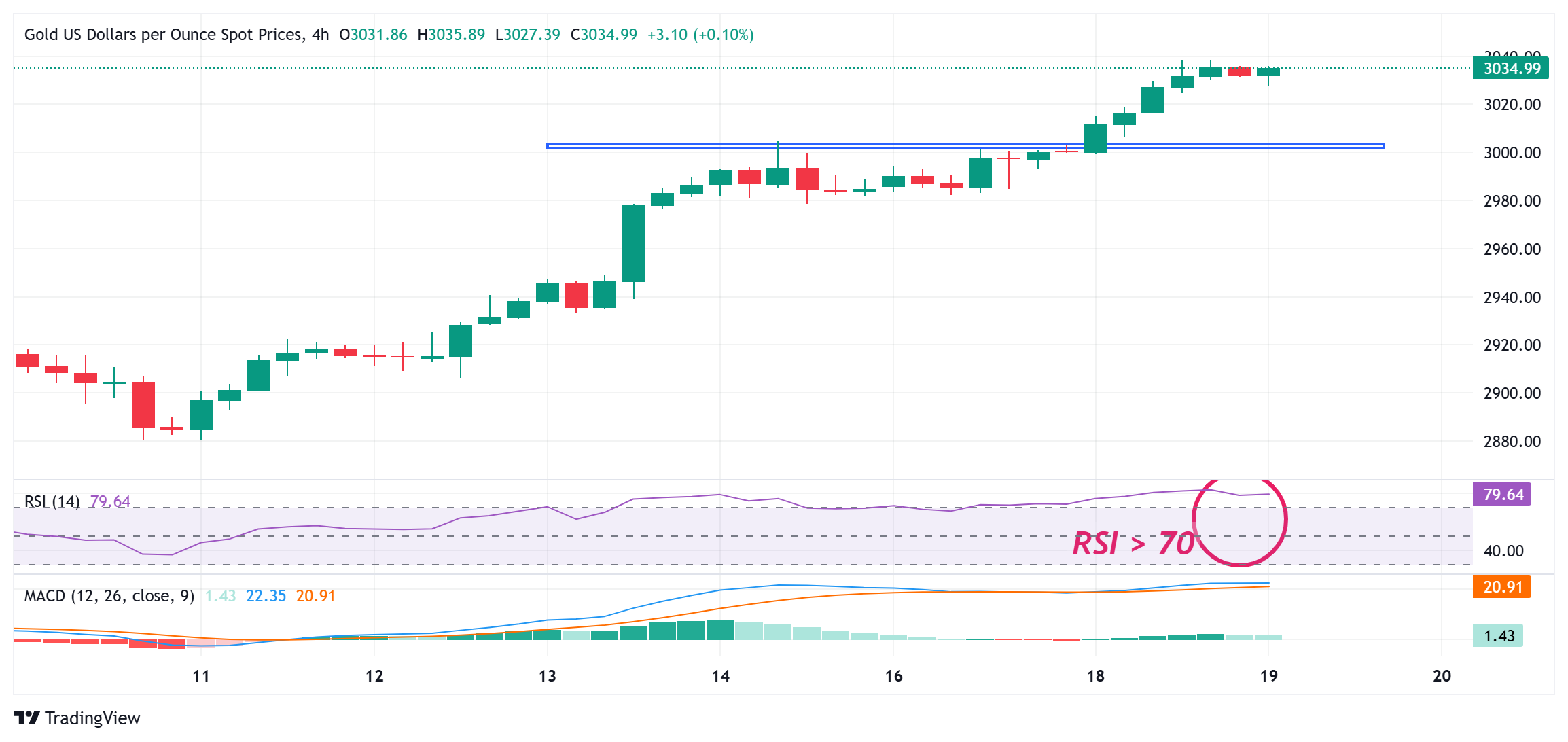Gold prices are trading near all-time highs amid rising geopolitical risks and trade tensions.
Fed rate cut bets are bullish for non-yielding gold and remain supported.
A modest dollar rebound capped gains for the commodity ahead of a key FOMC decision.
Gold prices (XAU/USD) entered a bullish consolidation phase, trading near all-time highs as bulls paused to take a breather, opting to await the outcome of the upcoming two-day FOMC policy meeting in the US session on Wednesday. The market consensus strongly suggests that the Federal Reserve (Fed) will keep the federal funds rate unchanged at the current range of 4.25% to 4.50%. As such, the focus will be on updated economic projections and the post-meeting press conference, with the market closely watching comments from Fed Chairman Jerome Powell for clues on the path of future rate cuts. This in turn will have a key impact on the near-term US dollar (USD) price dynamics and provide some meaningful impetus to non-yielding gold.
Some repositioning trades helped the dollar recover slightly from its lowest level since October last year hit on Tuesday amid the risk of key central bank events and acted as a headwind for gold prices. However, the downside for gold prices remains limited given the uncertainty surrounding US President Donald Trump's aggressive trade policies and their impact on the global economic outlook. Apart from this, the risk of further escalation of geopolitical tensions in the Middle East continues to support the safe-haven metal and underpin the multi-month uptrend. However, slightly overbought conditions on the daily chart may hinder traders from making fresh bullish bets on the gold/USD pair.
Gold prices surged to a new record high of around $3,038-3,039 on Tuesday as rising tensions in the Middle East and concerns about U.S. President Donald Trump's tariff plans continued to drive demand for safe-haven assets.
Israeli airstrikes on Hamas targets in Gaza killed more than 400 people. Israeli Prime Minister Benjamin Netanyahu said he ordered the airstrikes because Hamas rejected an offer to extend a ceasefire that has been in place since January.
Trump threatened to impose reciprocal and industry tariffs, which he said would take effect on April 2. This is on top of the 25% fixed tariffs on steel and aluminum imposed in February, further fueling concerns of a global trade war.
Traders are increasing bets that the Federal Reserve will have to cut interest rates earlier than expected this year as the Trump administration's aggressive policies could lead to a rising chance of a recession.
Current market pricing shows that the Fed is likely to cut interest rates by 25 basis points each at its monetary policy meetings in June, July and October, further supporting the now non-yielding gold.
The dollar rebounded slightly from a more than five-month low on Tuesday as traders chose to ease bearish bets ahead of the FOMC decision, which is expected to be released during the U.S. session on Wednesday.
The accompanying monetary policy statement and comments from Fed Chairman Jerome Powell will be closely watched for clues on the future path of rate cuts, which will drive demand for the dollar and affect the gold/dollar pair.

The daily Relative Strength Index (RSI) remains above 70, indicating slightly overbought conditions. With key central bank event risks approaching, this makes it prudent to wait for some short-term consolidation or a modest pullback before traders start positioning for any further appreciating moves. Meanwhile, the recent breakout and acceptance above the psychological $3,000 level suggests that the path of least resistance for gold prices remains to the upside.
Meanwhile, any corrective dips are likely to be seen as buying opportunities and remain limited around the $3,005-3,000 area. This is followed by support close to the $2,980-2,978 area, which, if broken, could trigger some technical selling and drag gold prices to the $2,956 area. The downward trajectory could extend further to the intermediate support of $2,930, and then XAU/USD could eventually fall to the $2,900 level, close to last week's low, around the $2,880 area.
Gold has played a key role in human history as it is widely used as a store of value and a medium of exchange. Currently, in addition to its lustre and use in jewellery, gold is widely viewed as a safe haven asset, meaning it is considered a good investment in turbulent times. Gold is also widely viewed as a hedge against inflation and currency debasement as it is not dependent on any particular issuer or government.
Central banks are the largest holders of gold. To support their currencies during turbulent times, central banks tend to diversify their reserves and buy gold to improve perceptions of economic and monetary strength. High gold reserves can be a source of confidence in a country's solvency. According to the World Gold Council, central banks added 1,136 tons of gold reserves in 2022, worth about $70 billion. This is the highest annual purchase on record. Central banks in emerging economies such as China, India and Turkey are rapidly increasing their gold reserves.
Gold is negatively correlated with the U.S. dollar and U.S. Treasuries, both of which are major reserve assets and safe havens. Gold tends to rise when the dollar depreciates, allowing investors and central banks to diversify their assets during turbulent times. Gold is also negatively correlated with risky assets. Stock market rebounds tend to push gold prices lower, while sell-offs in riskier markets tend to benefit gold.
Prices can move due to a variety of factors. Geopolitical instability or fears of a deep recession could quickly push gold prices higher due to its safe-haven status. As a low-yielding asset, gold tends to rise as interest rates fall, while higher funding costs usually weigh on gold. Still, since the asset is priced in U.S. dollars (XAU/USD), most moves depend on the performance of the U.S. dollar (USD). A strong dollar tends to control gold prices, while a weak dollar can push gold prices higher.